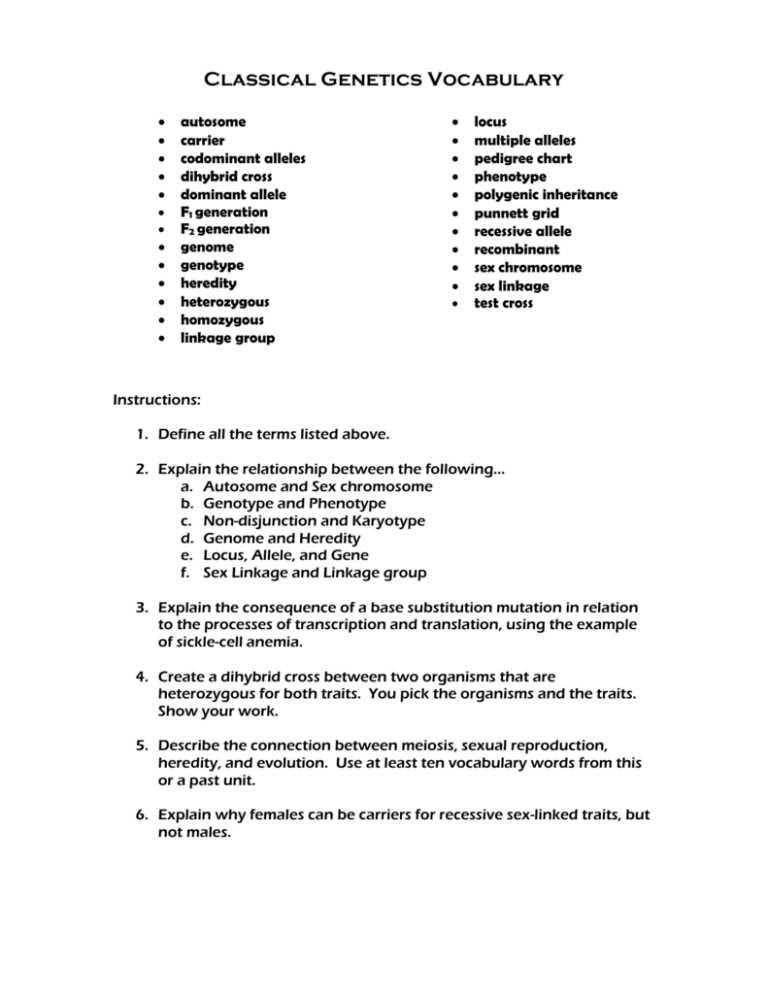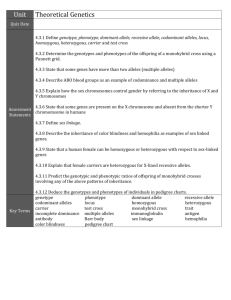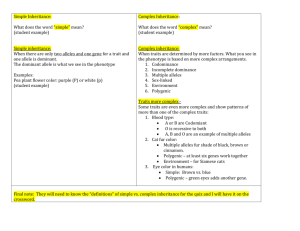Classical Genetics Vocabulary
advertisement

Classical Genetics Vocabulary autosome carrier codominant alleles dihybrid cross dominant allele F1 generation F2 generation genome genotype heredity heterozygous homozygous linkage group locus multiple alleles pedigree chart phenotype polygenic inheritance punnett grid recessive allele recombinant sex chromosome sex linkage test cross Instructions: 1. Define all the terms listed above. 2. Explain the relationship between the following… a. Autosome and Sex chromosome b. Genotype and Phenotype c. Non-disjunction and Karyotype d. Genome and Heredity e. Locus, Allele, and Gene f. Sex Linkage and Linkage group 3. Explain the consequence of a base substitution mutation in relation to the processes of transcription and translation, using the example of sickle-cell anemia. 4. Create a dihybrid cross between two organisms that are heterozygous for both traits. You pick the organisms and the traits. Show your work. 5. Describe the connection between meiosis, sexual reproduction, heredity, and evolution. Use at least ten vocabulary words from this or a past unit. 6. Explain why females can be carriers for recessive sex-linked traits, but not males. 4.1 Chromosomes, genes, alleles and mutations 4.1.1 State that eukaryote chromosomes are made of DNA and proteins. 4.1.2 Define gene, allele and genome. 4.1.3 Define gene mutation. 4.1.4 Explain the consequence of a base substitution mutation in relation to the processes of transcription and translation, using the example of sickle-cell anemia. 4.3 Theoretical genetics 4.3.1 Define genotype, phenotype, dominant allele, recessive allele, codominant alleles, locus, homozygous, heterozygous, carrier and test cross. 4.3.2 Determine the genotypes and phenotypes of the offspring of a monohybrid cross using a Punnett grid. 4.3.3 State that some genes have more than two alleles (multiple alleles). 4.3.4 Describe ABO blood groups as an example of codominance and multiple alleles. 4.3.5 Explain how the sex chromosomes control gender by referring to the inheritance of X and Y chromosomes in humans. 4.3.6 State that some genes are present on the X chromosome and absent from the shorter Y chromosome in humans. 4.3.7 Define sex linkage. 4.3.8 Describe the inheritance of colour blindness and hemophilia as examples of sex linkage. 4.3.9 State that a human female can be homozygous or heterozygous with respect to sex-linked genes. 4.3.10 Explain that female carriers are heterozygous for X-linked recessive alleles. 4.3.11 Predict the genotypic and phenotypic ratios of offspring of monohybrid crosses involving any of the above patterns of inheritance. 4.3.12 Deduce the genotypes and phenotypes of individuals in pedigree charts. 10.2 Dihybrid crosses and gene linkage 10.2.1 Calculate and predict the genotypic and phenotypic ratio of offspring of dihybrid crosses involving unlinked autosomal genes. 10.2.2 Distinguish between autosomes and sex chromosomes. 10.2.3 Explain how crossing over between non-sister chromatids of a homologous pair in prophase I can result in an exchange of alleles. 10.2.4 Define linkage group. 10.2.5 Explain an example of a cross between two linked genes. 10.2.6 Identify which of the offspring are recombinants in a dihybrid cross involving linked genes. 10.3 Polygenic inheritance 10.3.1 Define polygenic inheritance. 10.3.2 Explain that polygenic inheritance can contribute to continuous variation using two examples, one of which must be human skin colour.







